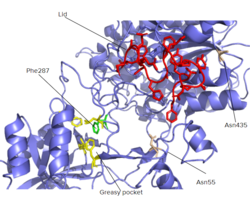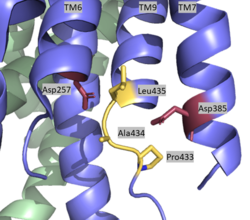Sandbox Reserved 1619
From Proteopedia
(Difference between revisions)
| Line 34: | Line 34: | ||
==Relevance== | ==Relevance== | ||
| - | Gamma secretase has been determined to be highly involved with diseases such as Alzheimer's disease (AD). In this, beta-amyloid build up leads to amyloid plaques in brain. These plaques then go on to cause severe neural dysfunction over time. Inhibition of gamma secretase could be potential AD treatment, but as stated earlier, this is a hard model to accomplish as gamma secretase is relevant with several different substrates. Complete inhibition would cause other severe problems beyond that of AD, making treatment more difficult than what meets the eye. However, what is known is that there are many different regions that give rise to gamma secretase malfunction when they are mutated. Over 200 of these mutations have been linked to causing AD. In particular, these mutations target so called "hot spots" on the enzyme and heavily impact the interface between PS1 and APP, affecting the integrity of catalysis and ultimately creating the plaques that impair neural function. Currently, in order to combat this complex situation, differences in binding between different substrates are being used to create drugs that selectively inhibit APP binding with gamma secretase, and possibly create a more ideal target for AD treatment. | + | Gamma secretase has been determined to be highly involved with diseases such as Alzheimer's disease (AD). In this, beta-amyloid build up leads to [https://en.wikipedia.org/wiki/Amyloid amyloid]plaques in brain. These plaques then go on to cause severe neural dysfunction over time. Inhibition of gamma secretase could be potential AD treatment, but as stated earlier, this is a hard model to accomplish as gamma secretase is relevant with several different substrates. Complete inhibition would cause other severe problems beyond that of AD, making treatment more difficult than what meets the eye. However, what is known is that there are many different regions that give rise to gamma secretase malfunction when they are mutated. Over 200 of these mutations have been linked to causing AD. In particular, these mutations target so called "hot spots" on the enzyme and heavily impact the interface between PS1 and APP, affecting the integrity of catalysis and ultimately creating the plaques that impair neural function. Currently, in order to combat this complex situation, differences in binding between different substrates are being used to create drugs that selectively inhibit APP binding with gamma secretase, and possibly create a more ideal target for AD treatment. |
Revision as of 00:11, 7 April 2020
Gamma Secretase
| |||||||||||
References
- ↑ Yang G, Zhou R, Shi Y. Cryo-EM structures of human gamma-secretase. Curr Opin Struct Biol. 2017 Oct;46:55-64. doi: 10.1016/j.sbi.2017.05.013. Epub, 2017 Jul 17. PMID:28628788 doi:http://dx.doi.org/10.1016/j.sbi.2017.05.013
- ↑ Bai XC, Yan C, Yang G, Lu P, Ma D, Sun L, Zhou R, Scheres SH, Shi Y. An atomic structure of human gamma-secretase. Nature. 2015 Aug 17. doi: 10.1038/nature14892. PMID:26280335 doi:http://dx.doi.org/10.1038/nature14892
- ↑ Zhou R, Yang G, Guo X, Zhou Q, Lei J, Shi Y. Recognition of the amyloid precursor protein by human gamma-secretase. Science. 2019 Feb 15;363(6428). pii: science.aaw0930. doi:, 10.1126/science.aaw0930. Epub 2019 Jan 10. PMID:30630874 doi:http://dx.doi.org/10.1126/science.aaw0930
Student Contributors
Layla Wisser
Daniel Mulawa


